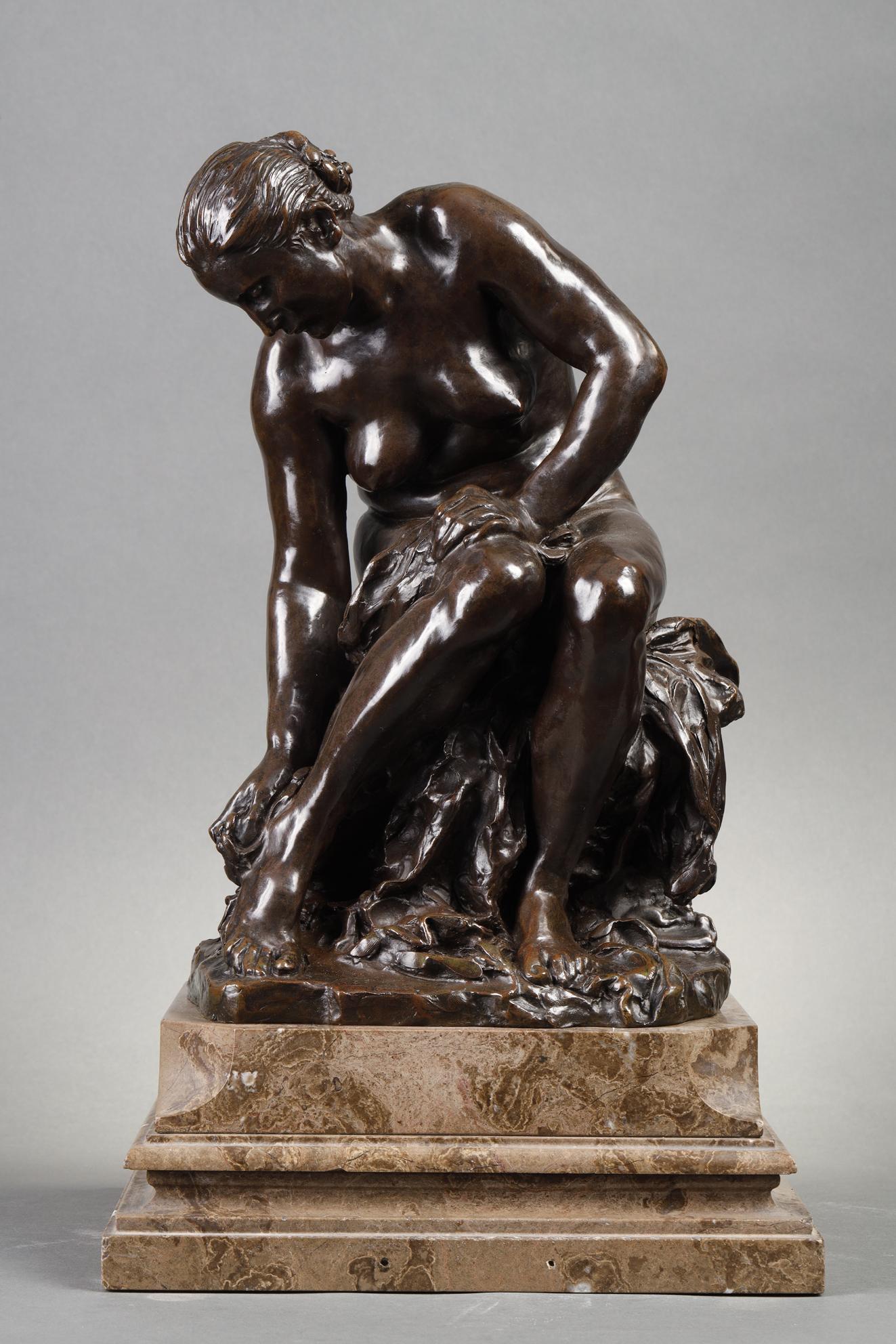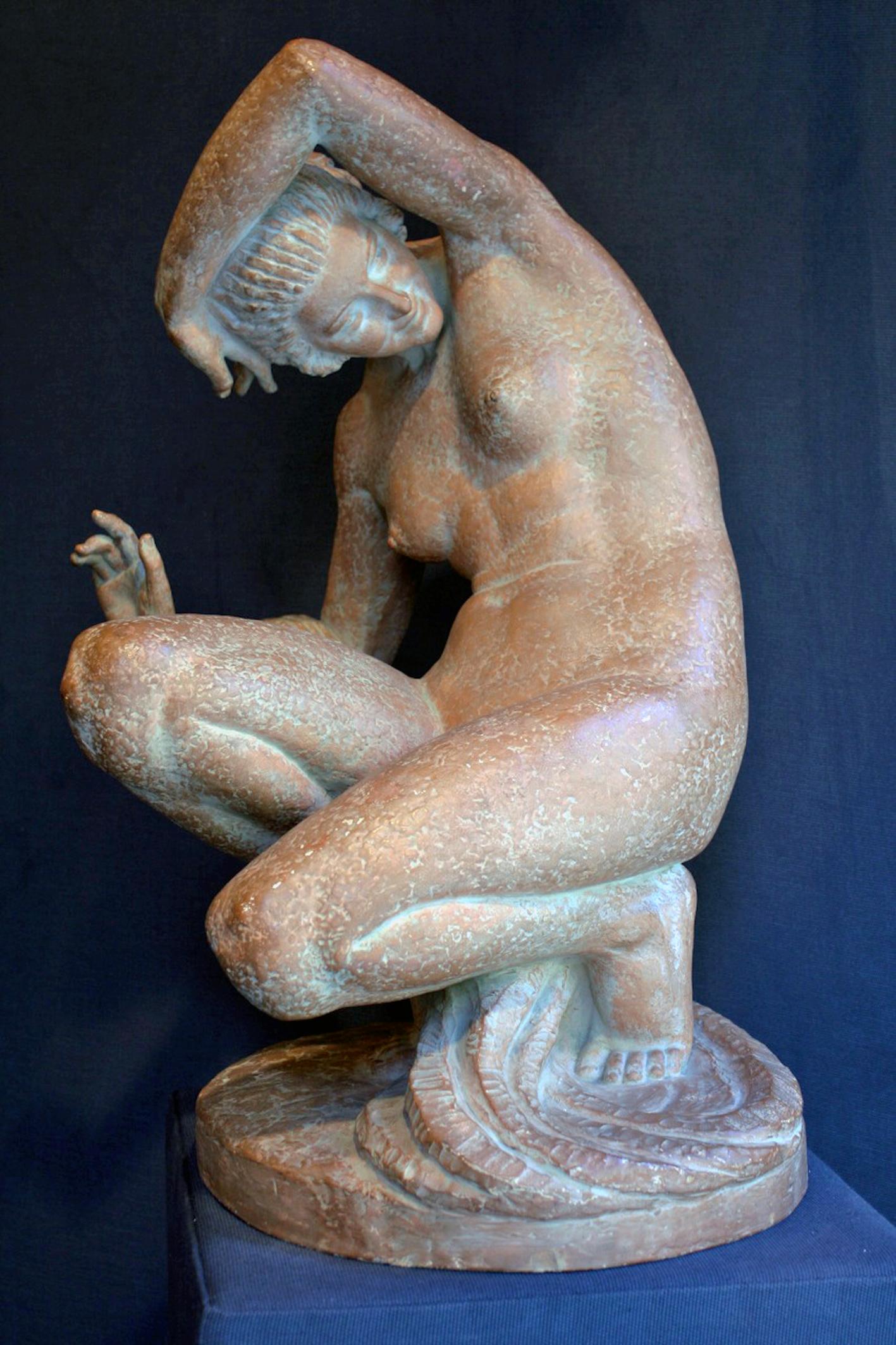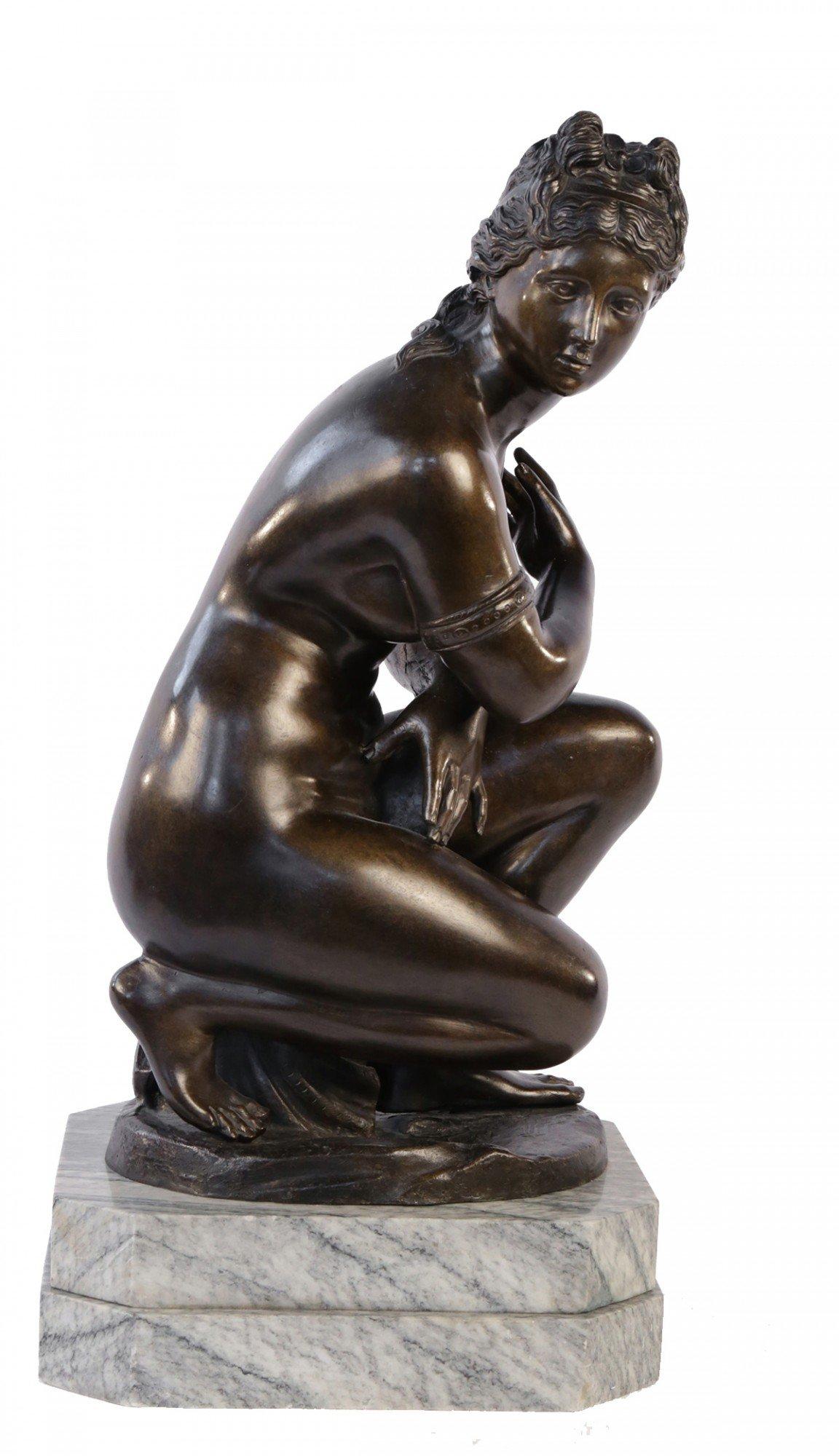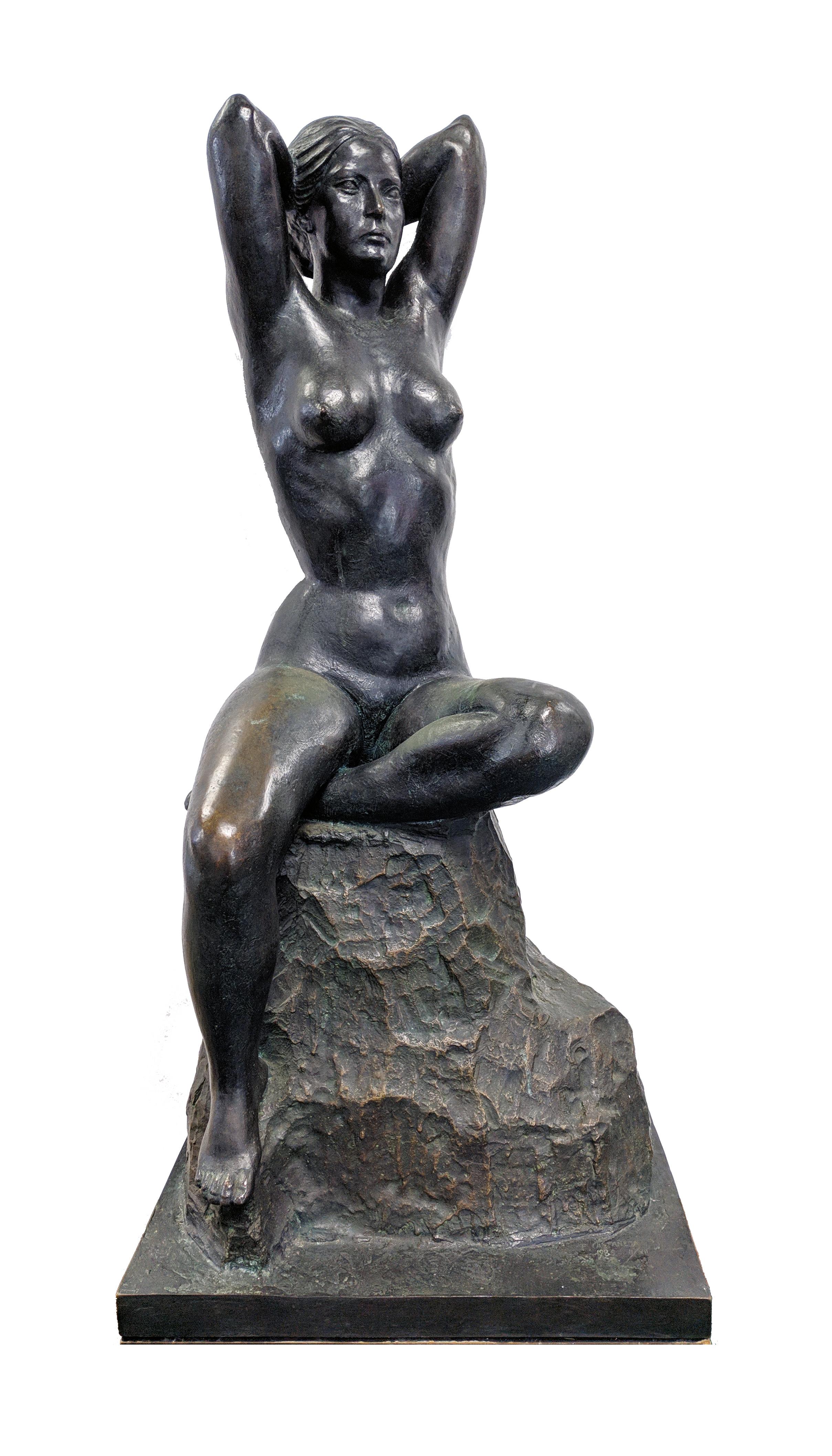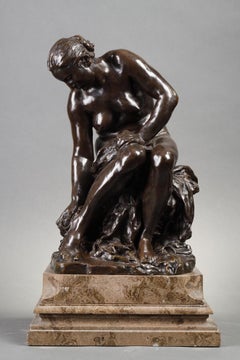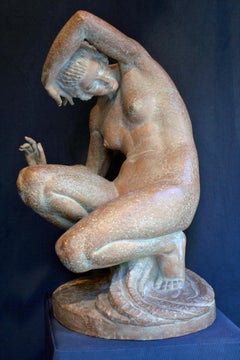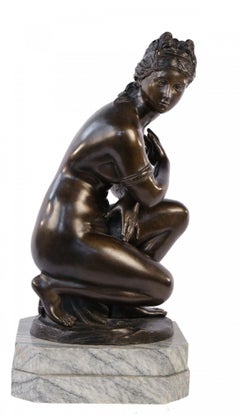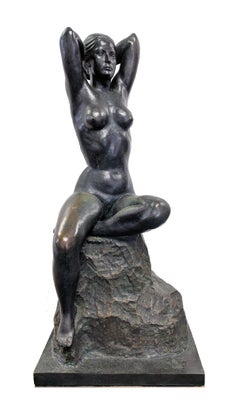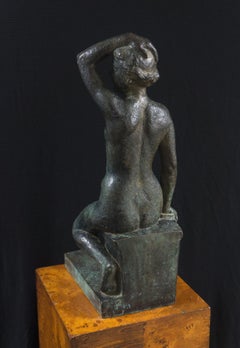Articles similaires à Bathing woman surprised
Vous voulez plus d'images ou de vidéos ?
Demander au vendeur plus d'images ou de vidéos
1 sur 20
Aimé-Jules DalouBathing woman surprisedcirca 1899
circa 1899
36 000 €TVA incluse
À propos de cet article
Bathing woman surprised
by Aimé-Jules DALOU (1838-1902)
A bronze sculpture with a nuanced dark brown patina
Signed to the rear " Dalou "
A very fine cast by " Susse Fres " (with the foundry mark and stamp used for "Susse Frères")
France
model created around 1899
cast around 1910
height 54 cm
width 29 cm
depth 26 cm
A similar model reproduced in "Jules Dalou, le sculpteur de la République", Exhibition held at the Musée du Petit Palais, Paris, 2013, page 383, n°310.
Biography :
Aimé-Jules Dalou, said Jules Dalou (1838-1902) was a French sculptor, born from Protestants glovers craftsmen who raised in secularism and love of the Republic. Jules Dalou was very young talented for modeling and drawing, which earned him the attention of Jean-Baptiste Carpeaux, who made him entered in 1852 in the Little School, the future National School of Decorative Arts in Paris. In 1854, he was admitted to the School of Fine Arts in Paris, where he studied painting in the workshop of Abel de Pujol and sculpture in the workshop of Francisque Duret. He began to earn his living by working for decorators, and began his friendship with Auguste Rodin. Dalou then produced decorative sculptures for buildings on major Parisian avenues, such as the Hotel de la Paiva, on the Champs-Elysees Avenue. He presented but failed four times to Rome prize competition, but exhibited at the 1869 Salon his "Daphnis and Chloe" and the "Embroiderer" at the Salon of 1870, two pieces acquired by the French state. Dalou had one child, Georgette, a girl born with a mental handicap. This is to ensure funding for her daughter's life accommodation in the Orphanage of Arts, that Dalou bequeathed the funds from his workshop to this institution.
After the bloody week of May 1871 Dalou, his wife and their daughter were threatened as Communards, forced into exile and requested asylum. They then joined England and were greeted by his former fellows of the Little School, the painter Alphonse Legros. With Legros, much introduced in the City, he made a serie of terracotta statuettes inspired by boulonnaise peasants or intimate subjects (readers, lullabies), and portraits of the English aristocracy. He became professor for modeling at the National Art Training School, his influence was decisive for many British sculptors. He received orders for a public fountain in marble titled "Charity" (1877) near the Royal Exchange in London, and a monument dedicated to Queen Victoria's grandchildren located in the private chapel of Frogmore at Windsor Castle.
In May 1874, the Paris War Council condemned Dalou in absentia to hard labor for life. Having refused to beg for mercy, he was only in May 1879 being granted amnesty and his family finally returned from exile. His group "The Triumph of the Republic", originally planned for the Place de la Republique in Paris, was finally erected on the Place du Trône, renamed Place de La Nation in 1880. Dalou devoted twenty years to the realization of this monument. The years 1881 and 1882 were difficult, but the 1883 Salon finally revealed him to the French public. He exhibited his two high reliefs: "The Brotherhood of Peoples" and "Mirabeau answering Dreux-Brézé", for which he was awarded the Medal of Honor. Fleeing the world and living in family, Dalou engaged in considerable work and many orders both private and public. For the Universal Exhibition of 1889, was inaugurated on the Place de la Nation the plaster of "The Triumph of the Republic" commissioned by the city of Paris in 1879. Although the bronze version of the group was inaugurated in 1899, this work won the grand prize for sculpture in the exhibition. Dalou left the French Society of Artists in 1890 to expose at the National Society of Fine Arts, of which he was a founding member with Ernest Meissonier, Auguste Rodin and Pierre Puvis de Chavannes. Awarded Knight of the Legion of Honor in 1883, and promoted to officer by President Carnot in 1889, he was elevated to the rank of Commander of the same order in 1899 by President Loubet at the inauguration of the monument of "The Triumph of the Republic".
Dalou had no time to complete his last great project, a monument dedicated to workers, the idea came to him in 1889 after the first opening of "TheTriumph of the Republic". The formality of the ceremony and military parades held the people away from the official event. Dalou was disappointed. True to its republican ideals, he had hoped that this inauguration was an opportunity of great popular democratic party (as it was at the inauguration of the bronze in 1899). His idea was then to pay tribute to the world of workers, craftsmen and peasants with this work being the central subject. At the end of his career Dalou described the project as follows: "I think I have finally found the monument to the workers that I seek since 1889. Sober, without molding or ornament, I wish it'd be severe and imposing. Will I execute it? There is the question. I am old and my health is so weak."
- Créateur:Aimé-Jules Dalou (1838 - 1902, Français)
- Année de création:circa 1899
- Dimensions:Hauteur : 54 cm (21,26 po)Largeur : 29 cm (11,42 po)Profondeur : 26 cm (10,24 po)
- Support:
- Mouvement et style:
- Période:
- État:
- Adresse de la galerie:PARIS, FR
- Numéro de référence:Vendeur : N.80611stDibs : LU2514217042302
À propos du vendeur
5,0
Vendeur reconnu
Ces vendeurs prestigieux sont des leaders du secteur. Ils représentent le summum en matière de qualité et de design.
Vendeur Or
Vendeurs premium dont la note est supérieure à 4,3 et le délai de réponse de 24 heures maximum
Établi en 1992
Vendeur 1stDibs depuis 2023
10 ventes sur 1stDibs
Temps de réponse habituel : 12 heures
- ExpéditionRecherche du devis...Expédition depuis : PARIS, France
- Politique des retours
Certaines parties de cette page ont été traduites automatiquement. 1stDibs ne garantit pas l'exactitude des traductions. L'anglais est la langue par défaut de ce site web.
Garantie d'authenticité
Bien qu'il soit peu probable que la situation se présente, dans le cas où vous rencontreriez un problème d'authenticité d'un article, contactez-nous dans un délai d'un an pour obtenir un remboursement intégral. DétailsGarantie de remboursement
Si votre article n'est pas conforme à la description, est endommagé pendant le transport ou ne vous est pas livré, contactez-nous sous 7 jours pour obtenir un remboursement intégral. DétailsAnnulation sous 24 heures
Vous disposez d'un délai de 24 heures pour annuler votre achat sans motif.Des vendeurs professionnels agréés
Nos vendeurs de renommée mondiale doivent respecter des normes strictes en matière de service et de qualité, afin de préserver l'intégrité de nos fiches produit.Garantie d'alignement des prix
Si vous constatez qu'un autre vendeur a mis en vente le même article à un prix inférieur sur un autre site, nous nous alignerons sur ce prix.Livraison en toute confiance à l'international
Notre réseau de transporteurs de premier ordre propose des options d'expédition spécialisées dans le monde entier, y compris des livraisons personnalisées.Plus d'articles de ce vendeur
Tout afficherDésespéré
Par Aimé-Jules Dalou
Désespéré
par Jules DALOU (1838-1902)
Sculpture en bronze à la patine brun-vert foncé nuancée
Signé sur la base " Dalou "
Coulée par " Susse Frères Editeurs Paris " (avec la marque...
Catégorie
Fin du XIXe siècle, École française, Sculptures - Nus
Matériaux
Bronze
9 000 €
Suzanne
Par Aimé-Jules Dalou
Femme se baignant et s'essuyant le pied droit
également connue sous le nom de "Suzanne"
par Aimé-Jules DALOU (1838-1902)
Sculpture en bronze à la patine brun foncé nuancée
Signé su...
Catégorie
Début du 20ème siècle, École française, Sculptures - Figuratif
Matériaux
Bronze
Jeune femme assise avec draperie
Jeune femme assise avec draperie
par Pierre-Marie POISSON (1876-1953)
Sculpture en bronze à patine verte nuancée
signé sur la base "P. Poisson"
ancienne fonte
France
vers 1935-40
...
Catégorie
années 1930, École française, Sculptures - Nus
Matériaux
Bronze
La naissance de Vénus
Par Albert-Ernest Carrier-Belleuse 1
La naissance de Vénus
par Albert-Ernest CARRIER-BELLEUSE (1824-1887)
Sculpture en bronze à patine brun foncé nuancée
signé "A. Carrier-Belleuse"
distribution par Denière
France
ve...
Catégorie
Fin du XIXe siècle, École française, Sculptures - Figuratif
Matériaux
Bronze
Diana avec une flèche
Par Albert-Ernest Carrier-Belleuse
Diana avec une flèche
par Albert-Ernest CARRIER-BELLEUSE (1824-1887)
Sculpture en bronze à double patine brun clair et brun foncé
signé sur la base "Carrier-Belleuse".
inscrit sur ...
Catégorie
années 1870, École française, Sculptures - Nus
Matériaux
Bronze
La naissance de Vénus
Par Albert-Ernest Carrier-Belleuse
La naissance de Vénus
par Albert-Ernest CARRIER-BELLEUSE (1824-1887)
Sculpture en bronze à double patine, brun foncé nuancé et patine dorée
signé "A. Carrier-Belleuse"
France
vers...
Catégorie
années 1870, École française, Sculptures - Figuratif
Matériaux
Bronze
Suggestions
Sculpture de nu féminin en terre cuite de Marcel Bouraine (1886-1948)
Par Marcel-André Bouraine
Sculpture en terre cuite de Marcel Bouraine (1886-1948)"
Sculpture originale en terre cuite de Marcel Bouraine
La Naïade des années 1930 signée Bouraine
Sur le socle Hauteur : 60 cm - Diamètre socle : 30 cm Parfait état.
Pas de restauration
Marcel BOURAINE (1886-1948)
Sculpteur français du 20ème...
Catégorie
années 1930, Académique, Sculptures - Nus
Matériaux
Terre cuite
Figure de Vénus accroupie/Aphrodite nue, sculpture de l'école italienne du XIXe siècle
Figure en bronze de Vénus accroupie ou d'Aphrodite nue, école italienne du XIXe siècle
Bronze monté sur un socle en marbre
21 in. h. x 10 in. w. x 7 in. d., total
18 in. h. x 8.5 in...
Catégorie
XIXe siècle, Sculptures - Figuratif
Matériaux
Marbre, Bronze
SANS TITRE (NU)
Par Felipe Castañeda
Sculpture en bronze. Signature de l'artiste incisée avec la date et l'édition. La taille comprend la base. Des images supplémentaires sont disponibles sur demande. Le certificat d'...
Catégorie
années 1980, Contemporain, Sculptures - Figuratif
Matériaux
Bronze
17 816 € Prix de vente
30 % de remise
Nu assis", Paris, Académie Chaumière, Salon d'Automne, LACMA, Femme sculpteur
Par Caroline Lloyd
Signé 'Lloyd' pour Caroline Lloyd (américaine, 1875-1945), créé vers 1935 et portant le cachet de la fonderie, 'C. Valsuani Cire Perdue", pour Claude Valsuani Fonderie, Paris.
Rema...
Catégorie
années 1930, Sculptures - Nus
Matériaux
Bronze
Etienne Falconet Sculpture de Diane La Baigneuse (la baigneuse) 1716-1796
Par Étienne Maurice Falconet
D'après Etienne-Maurice Falconet (français 1716 - 1791) La Baigneuse
Grande sculpture de Diane au puits, d'une hauteur de 29 pouces.
Mesure 8,5" de la...
Catégorie
20ième siècle, Français, Beaux-Arts, Sculptures - Figuratif
Matériaux
Bronze, Cuivre
Sculpture italienne d'une femme nue en bronze de Vincenzo Aurisicchio datant de 1800
Sculpture en bronze d'un beau nu féminin, réalisée par Vincenzo Aurisicchio dans la deuxième partie du XIXe siècle. La sculpture en bronze est en très bon état.
Ø cm 23 Ø cm 14 h c...
Catégorie
Antiquités, années 1880, italien, Mouvement esthétique, Sculptures - Fig...
Matériaux
Bronze
1 540 € Prix de vente
20 % de remise
